To expand on @G5W's excellent point:
library(dplyr)
library(ggplot2)
df <- structure(
list(
V1 = 1:10,
V2 = c(
0.31707317,
0.12195122,
0.09756098,
0.07317073,
0.07317073,
0.07317073,
0.07317073,
0.07317073,
0.04878049,
0.04878049
)
),
.Names = c("V1", "V2"),
class = "data.frame",
row.names = c(NA, -10L))
You can calculate each triangle from its neighbor to the right using dplyr::lead:
areas <- df %>%
setNames(c("variable", "value")) %>%
mutate(nextval = lead(value, default = value[1]),
angle = (1/10) * (2*pi),
# change 1/n to number of variables
area = value*nextval*sin(angle)/2)
variable value nextval angle area
1 1 0.31707317 0.12195122 0.6283185 0.0113640813
2 2 0.12195122 0.09756098 0.6283185 0.0034966406
3 3 0.09756098 0.07317073 0.6283185 0.0020979843
4 4 0.07317073 0.07317073 0.6283185 0.0015734881
5 5 0.07317073 0.07317073 0.6283185 0.0015734881
6 6 0.07317073 0.07317073 0.6283185 0.0015734881
7 7 0.07317073 0.07317073 0.6283185 0.0015734881
8 8 0.07317073 0.04878049 0.6283185 0.0010489921
9 9 0.04878049 0.04878049 0.6283185 0.0006993281
10 10 0.04878049 0.31707317 0.6283185 0.0045456327
A couple things: notice that I used the default = value[1] to make sure that the NA that would be caused at the end to wrap around to using the first value instead. Also you need to use angles in radians, so that's just 1/n * 2pi. Now that we have all the triangle areas, we can add them:
areas %>% summarise(total = sum(area))
total
1 0.02954661
This approach is easily extended to multiple groups to compare.
df <- expand.grid(var = 1:8, grp = c("a", "b")) %>%
mutate(value = runif(length(var), 0.25, 1)) %>%
group_by(grp) %>%
mutate(nextval = lead(value, default = value[1]),
angle = (1/8)*(2*pi),
area = value*nextval*sin(angle)/2) %>%
mutate(total = sum(area))
# A tibble: 16 x 7
# Groups: grp [2]
var grp value nextval angle area total
<int> <fctr> <dbl> <dbl> <dbl> <dbl> <dbl>
1 1 a 0.3101167 0.6831233 0.7853982 0.07489956 0.5689067
2 2 a 0.6831233 0.4166692 0.7853982 0.10063417 0.5689067
3 3 a 0.4166692 0.4756976 0.7853982 0.07007730 0.5689067
4 4 a 0.4756976 0.3426595 0.7853982 0.05763002 0.5689067
5 5 a 0.3426595 0.3107870 0.7853982 0.03765135 0.5689067
6 6 a 0.3107870 0.3001208 0.7853982 0.03297721 0.5689067
7 7 a 0.3001208 0.9039894 0.7853982 0.09592115 0.5689067
8 8 a 0.9039894 0.3101167 0.7853982 0.09911594 0.5689067
9 1 b 0.9888119 0.3481213 0.7853982 0.12170243 1.1749789
10 2 b 0.3481213 0.8513316 0.7853982 0.10478143 1.1749789
11 3 b 0.8513316 0.9928401 0.7853982 0.29883611 1.1749789
12 4 b 0.9928401 0.6372992 0.7853982 0.22370605 1.1749789
13 5 b 0.6372992 0.8303906 0.7853982 0.18710303 1.1749789
14 6 b 0.8303906 0.3607232 0.7853982 0.10590379 1.1749789
15 7 b 0.3607232 0.2786354 0.7853982 0.03553575 1.1749789
16 8 b 0.2786354 0.9888119 0.7853982 0.09741033 1.1749789
df %>%
ggplot(aes(var, value)) +
geom_polygon() +
geom_text(aes(0,0, label = round(total, 2)), color = "white") +
facet_grid(~grp) +
scale_y_continuous("", limits = c(0, 1), expand = c(0,0)) +
scale_x_continuous("", breaks = 1:8, expand = c(0,0)) +
theme_minimal() +
coord_radar()

If you're doing a lot of these, it's worth looking at the ggradar package: http://www.ggplot2-exts.org/ggradar.html
Since I was just doing this one-off, I used a polar coordinate modification from Erwan Le Pennec:
http://www.cmap.polytechnique.fr/~lepennec/R/Radar/RadarAndParallelPlots.html
coord_radar <- function (theta = "x", start = 0, direction = 1)
{
theta <- match.arg(theta, c("x", "y"))
r <- if (theta == "x")
"y"
else "x"
ggproto("CoordRadar", CoordPolar, theta = theta, r = r, start = start,
direction = sign(direction),
is_linear = function(coord) TRUE)
}


